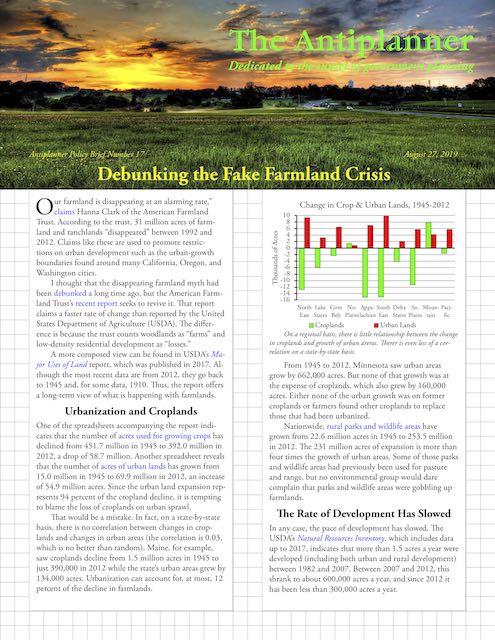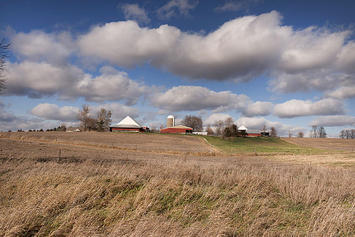
“Our farmland is disappearing at an alarming rate,” claims Hanna Clark of the American Farmland Trust. According to the trust, 31 million acres of farmland and ranchlands “disappeared” between 1992 and 2012. Claims like these are used to promote restrictions on urban development such as the urban-growth boundaries found around many California, Oregon, and Washington cities.
Click image to download a four-page PDF of this policy brief.
I thought that the disappearing farmland myth had been debunked a long time ago, but the American Farmland Trust’s recent report seeks to revive it. That report claims a faster rate of change than reported by the United States Department of Agriculture (USDA). The difference is because the trust counts woodlands as “farms” and low-density residential development as “losses.”
A more composed view can be found in USDA’s Major Uses of Land report, which was published in 2017. Although the most recent data are from 2012, they go back to 1945 and, for some data, 1910. Thus, the report offers a long-term view of what is happening with farmlands.
No Correlation Between Croplands and Urban Areas
One of the spreadsheets accompanying the report indicates that the number of acres used for growing crops has declined from 451.7 million in 1945 to 392.0 million in 2012, a drop of 58.7 million. Another spreadsheet reveals that the number of acres of urban lands has grown from 15.0 million in 1945 to 69.9 million in 2012, an increase of 54.9 million acres. Since the urban land expansion represents 94 percent of the cropland decline, it is tempting to blame the loss of croplands on urban sprawl.
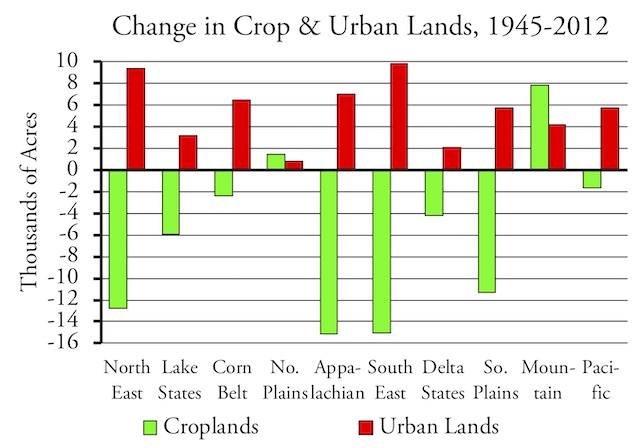
On a regional basis, there is little relationship between the change in croplands and growth of urban areas. There is even less of a correlation on a state-by-state basis.
That would be a mistake. In fact, on a state-by-state basis, there is no correlation between changes in croplands and changes in urban areas. Maine, for example, saw croplands decline from 1.5 million acres in 1945 to just 390,000 in 2012. In that time, the state’s urban areas grew by 134,000 acres, meaning that urbanization can account for, at most, 12 percent of the decline in farmlands.
From 1945 to 2012, Minnesota saw urban areas grow by 662,000 acres. But none of that growth was at the expense of croplands, which also grew by 160,000 acres. Either none of the urban growth was on former croplands or farmers found other croplands to replace those that had been urbanized.
Nationwide, rural parks and wildlife areas have grown from 22.6 million acres in 1945 to 253.5 million in 2012. The 231 million acres of expansion is more than four times the growth of urban areas. Some of those parks and wildlife areas had previously been used for pasture and range, but no environmental group would dare complain that parks and wildlife areas were gobbling up farmlands.
The Rate of Development Has Slowed
In any case, the pace of development has slowed. The USDA’s Natural Resources Inventory, which includes data up to 2017, indicates that more than 1.5 million acres a year were developed (including both urban and rural development) between 1982 and 2007. Between 2007 and 2012, this shrank to about 600,000 acres a year, and since 2012 it has been less than 300,000 acres a year.
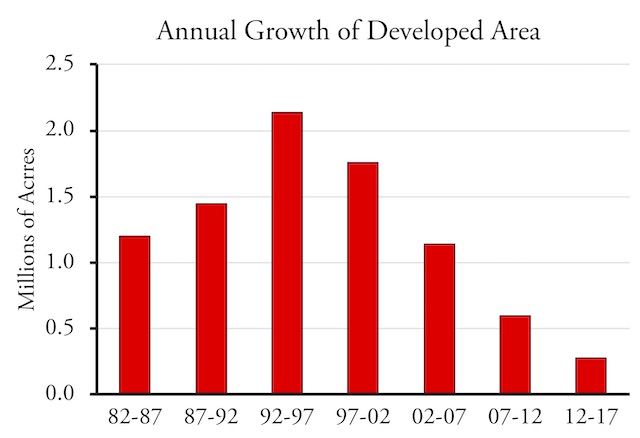
According to USDA’s Natural Resources Inventory, the pace of land development, including both urban and rural development, has dramatically slowed since the early 1990s.
There’s a good reason for this decline. New home construction is roughly proportional to the rate of new household formation. According to census data, in most years between World War II and 1982, the number of households grew by 2 percent per year or more. By 1992 this had shrunk to 1.5 percent per year, and by 2013 it had fallen below 1 percent per year.
Even before this decline in the rate of development, a USDA report noted that urbanization was “not considered a threat to the Nation’s food production overall.” If anything, it is even less of a threat today.
Huge Surplus of Agricultural Lands
For what development does take place, farmers can easily find more land for growing crops because, as reported in table 1 of Major Uses of Land, the United States has a huge base of agricultural land: nearly 1.2 billion acres. Croplands represent less than a third of those acres.
The remaining two-thirds of agricultural lands are devoted to low-intensity uses such as pasture, livestock grazing, and woodlands (forests that are also used for grazing). Even if urban development was converting a million acres of farms a year, it would take 750 years before it would have an effect on croplands.
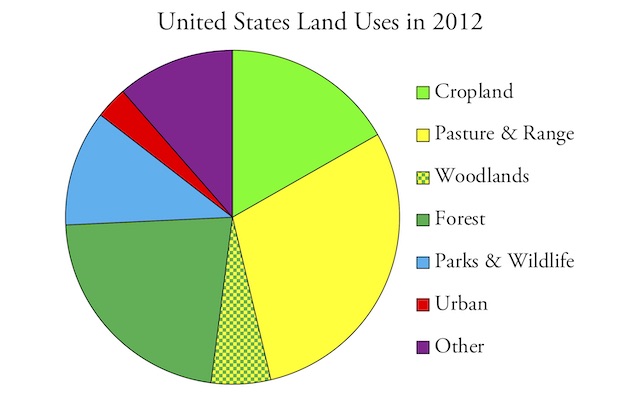
Counting woodlands (forests that are also used for grazing), more than half the land in the United States is agricultural, while urban areas cover only about 3 percent of the nation. “Other” includes defense, transportation, mountains, desert, and other minor categories.
The American Farmlands Trust report argues that some of the lands converted to other uses are “the best land for intensive food and crop production.” That may be true, but the cost of improving land for growing crops is low compared with the cost of land-use restrictions aimed at protecting farms that have added trillions of dollars to the cost of housing.
Bloomberg points out that only about 77 million acres of farms are used to grow the food that Americans eat, while another 127 million are used for growing feed for livestock, most of which Americans eat. That leaves more than 180 million acres of croplands used for growing food for export (84 million acres), making ethanol (38 million acres), cotton or other non-food products (14 million acres), or left fallow (52 million acres).
If we truly needed more acres to feed people, many of the nation’s 655 million acres of pasture and rangelands and even some of the 130 million acres of woodlands could be converted to croplands. A 1975 USDA report (not available on line but cited in this book from Resources for the Future) found that, at then-current crop prices, 110 million acres had “medium” to “high” potential for such conversions. Two years later USDA increased this to 127 million acres due to higher crop prices.
Such conversions would not reduce the ability of the country to grow cattle and other livestock that currently use pasture and rangelands. Bloomberg observes that “41% of the contiguous U.S. is used for feeding livestock.” But this includes 158 million acres of federal range lands, most of which only see a handful of livestock for a few months of the year. Only about 10 percent of cattle and sheep grown in the U.S. ever use this land, and federal land livestock grazing could end tomorrow and no one would notice except the ranchers who have become dependent on federal subsidies to public land grazing.
Many private rangelands are also used for low-intensity livestock grazing, and aren’t really needed for the nation’s food production. This is simply a matter of the United States having so much land that some owners resort to using their land for livestock because range management costs are low and it isn’t needed for anything else.
Per Acre Yields Growing Faster Than Population
The real cause of the decline in croplands since 1945 is not development, and the reason why more pasture and rangelands haven’t been converted to croplands is improved crop yields. According to USDA’s Crop Production Historical Track Records, between 1945 and 2018, the average per-acre yields of major crops including barley, corn, cotton, oats, rice, potatoes, and wheat grew much faster than the nation’s population. Yields of corn increased 433 percent; cotton 230 percent; rice 276 percent; and potatoes 372 percent. In the same time period, the nation’s population grew by 134 percent, which means the number of acres needed to feed the nation has steadily declined.
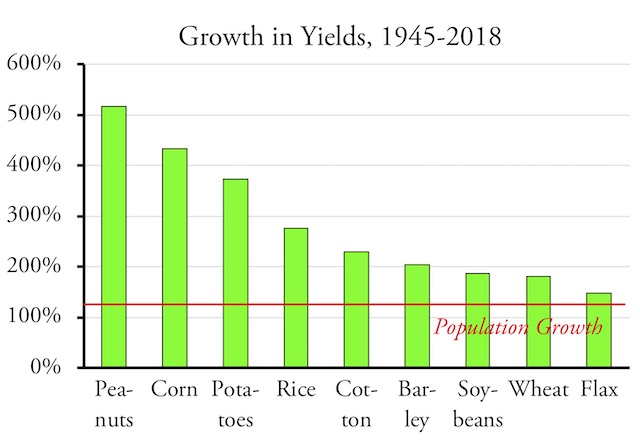
The yields per acre of most major crops have been growing much faster than the nation’s population, leading to a reduction in the need for croplands.
There is room for even more improvements in crop yields. About 330,000 acres are used for growing tomatoes in the United States. Tomatoes weren’t included in Crop Production Historical Track Records, but like the crops which were, tomato yields have increased 280 percent since 1960, the earliest year for which data are available. But hydroponic methods can increase yields many more times, allowing farmers to grow the same number of tomatoes on less than 20,000 acres.
Cropland Prices Flat Since 2014
If the farmland crisis were real, then farmland prices would be skyrocketing. Indeed, the average price of cropland nearly doubled from $2,060 in 2005 to $4,090 in 2014, but that increase wasn’t due to a shortage of farmlands. Instead, it resulted from increased demand on the world market, especially from China.
USDA price indices show that crop prices grew by 92 percent between 2005 and 2012. When combined with an 8 percent increase in per acre yields, this explains all of the increase in land prices.
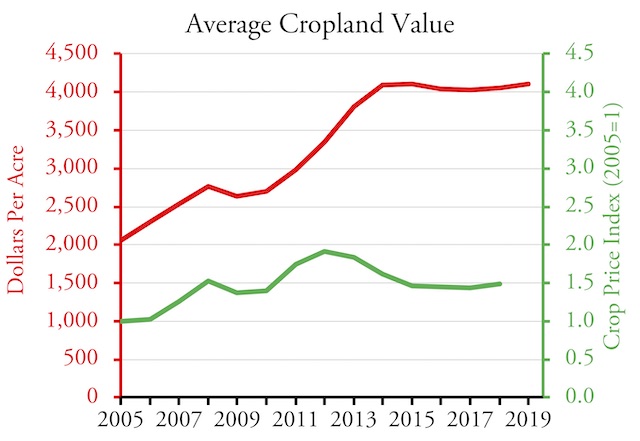
Cropland values doubled between 2005 and 2014, but this was due to a near-doubling of crop prices. Prices and land values have been flat or declined slightly since then. USDA price indices only go through 2015; for this chart, they are estimated after that based on Crop Production Historical Track Records.
Since 2013, crop prices have declined an average of 19 percent. Land prices similarly have stagnated, growing by an average of just $10 an acre to $4,100, which considering inflation is also a decline.
According to a 2017 review of urban land values by economists from the University of Illinois and University of Michigan, the value of land in major American urban areas ranges from about $200,000 an acre in Indianapolis, Kansas City, San Antonio, and St. Louis to more than $2 million an acre in Los Angeles, San Francisco, Honolulu, and New York. The market is sending a clear signal that it is urban land that is scarce, not rural or farm land.
More Harm Than Good
Policies enacted to “preserve farmland” can actually do more harm that good. Hawaii passed a land-use law in 1961 that heavily restricted urban encroachments on rural areas. The result is that housing prices today are so high that farmers can’t afford to pay farm workers enough to allow the farm workers to afford housing. This is effectively destroying the state’s agricultural economy, with harvested croplands declining more than 50 percent from 176,410 acres in 1959 to just 84,767 acres in 2017.
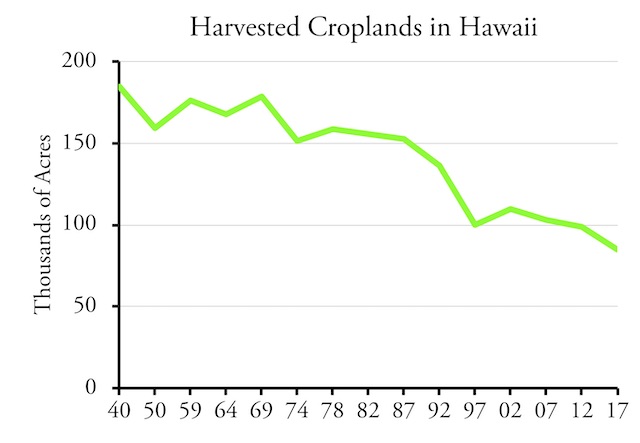
Hawaiian land-use policies intended to protect agriculture have made housing so expensive that farm workers can’t afford to live there, leading farmers to reduce the number of acres used for growing crops by more than 50 percent.
San Jose drew an urban-growth boundary in 1974 that put rolling hills surrounding the urban area off limits to development. These marginal agricultural lands are used to graze a few head of livestock. Meanwhile, housing prices in San Jose have become so expensive that people build homes on prime farmlands in California’s Central Valley and commute 85 miles to jobs in Silicon Valley.
Why a Crisis?
Despite farmlands being so abundant, the menace of a farmland crisis is frequently raised for several reasons. One is that some people are willing to use this imaginary threat to attain some other goal, such as urban densification. Another is that many people are stuck in a Malthusian mindset that can’t imagine that crop yields could possibly increase faster than the population. And a third reason is because the urban residents who are most likely to believe such a fallacy are out of touch with rural cultures and agricultural economics. If everything you see from your home is developed, it is easy to imagine that the nation is being paved over when in fact 97 percent of the country is rural open space.
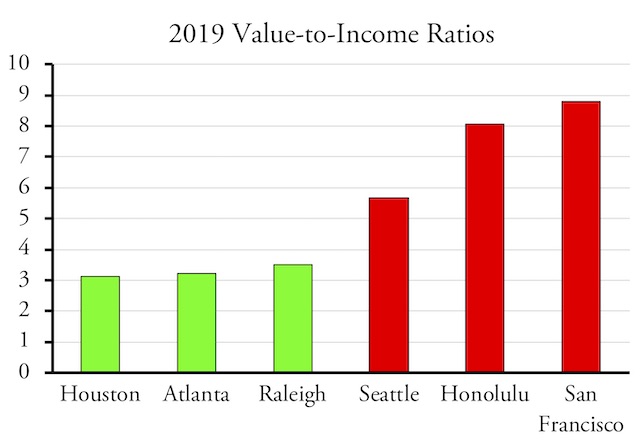
According to Zillow, housing is far less affordable, as measured by median home values divided by median family incomes, in regions that have adopted land-use policies aimed at preserving farmlands, shown in red, than regions that had not adopted such policies, shown in green
The reality is that there is no farmland crisis. There is, however, a real housing crisis in precisely the places that have tried to preserve farmlands by restricting rural development. Just as the disparity between cropland and urban land prices shows that there is no shortage of farms, the disparity in housing prices between regions that have restricted rural development and those that have not is a market signal that rural land restrictions are doing those regions more harm than good. Policy makers need to better understand land economics so they can address the real issues rather than fake ones like supposedly disappearing farmlands.
This piece first appeared in The Antiplanner.
Photo credit: Carol M. Highsmith via Wikimedia under CC 4.0 License
